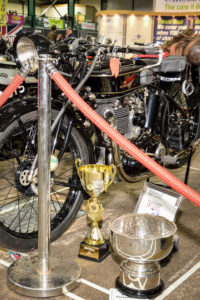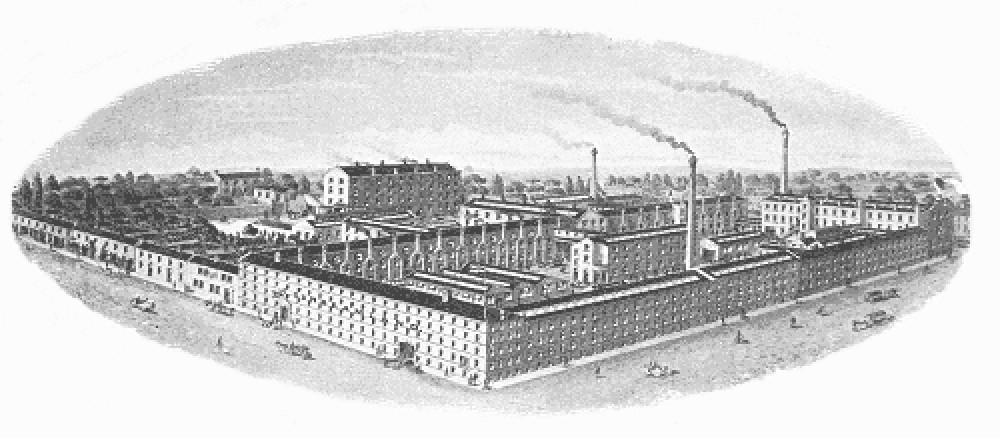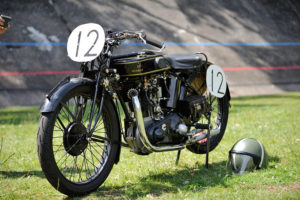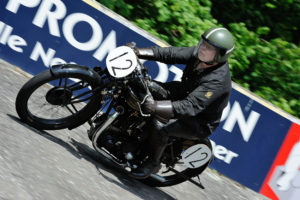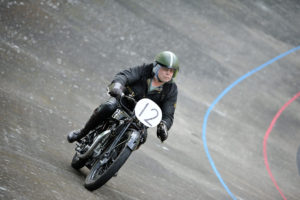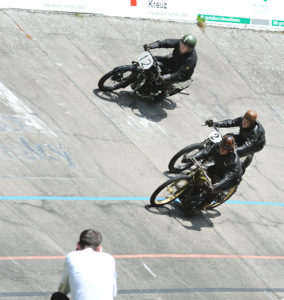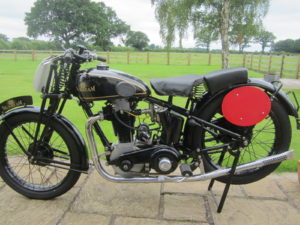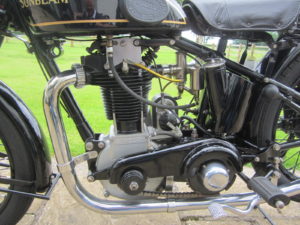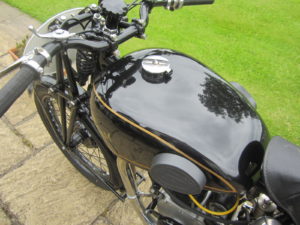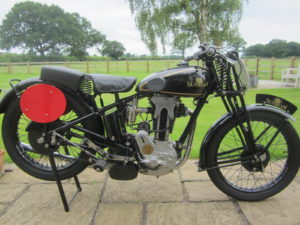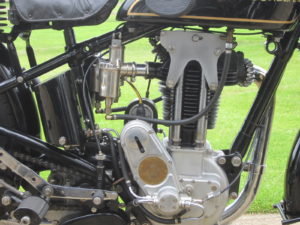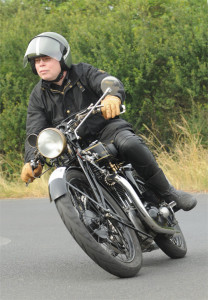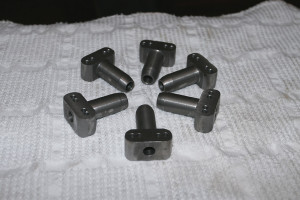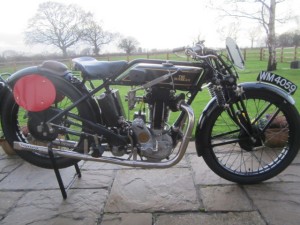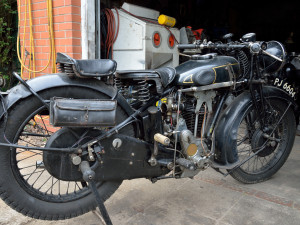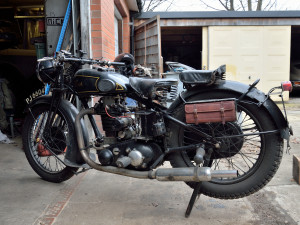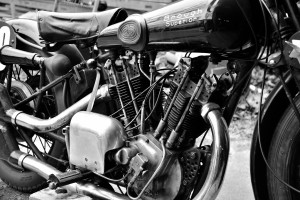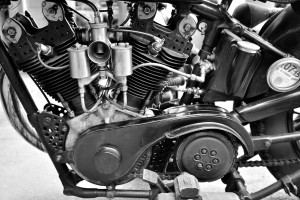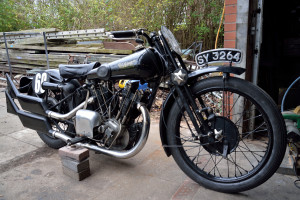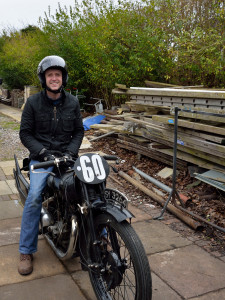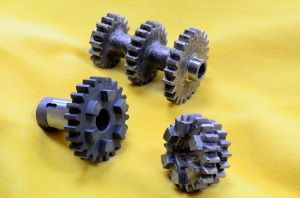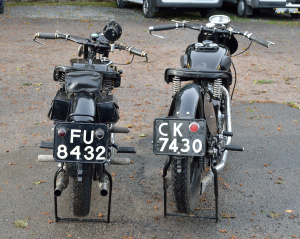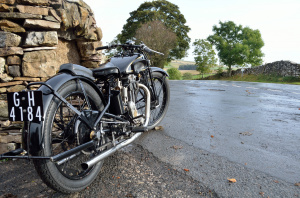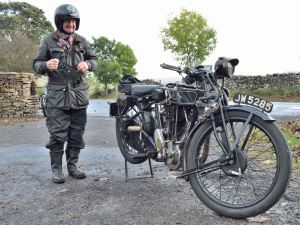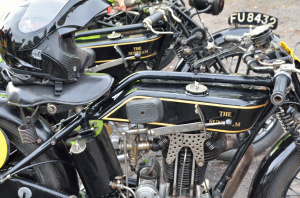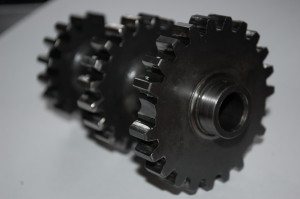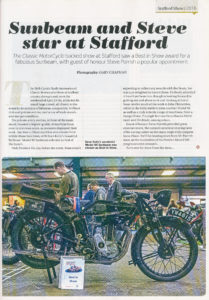
I’d like to say thankyou to John Phizacklea and Chris Odling for everything they have done in putting together this 1928 Model 90. A special thanks also goes to Peter Woodward, the talented gentleman who started the project all those years ago.
Peter originally sold me the bike as a rather large pile of bits back in 2012 as I had advertised for a “bull-nose” 90 in the club magazine. It was a rare sunny afternoon when Archie came along with me to have a look and we spent a pleasant few hours going through it all. I was only dimly aware of the quality of the project we were being presented with and whilst Archie dozed on the grass in the sun, Peter and I sealed the deal.
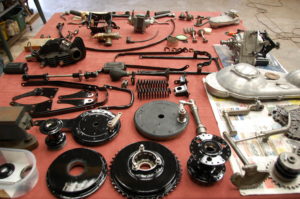
However, whilst much of the work had been completed, there was still plenty to be done with the priority being to rescue the bottom-end of the motor which evidence suggested had suffered at least one catastrophic event in its history. This is where Chris Odling stepped in and the long process of rework, rebuild and restore began. Expertise, knowledge and confidence are required in spades to even contemplate this type of engineering. The crankcases were welded and re-machined.
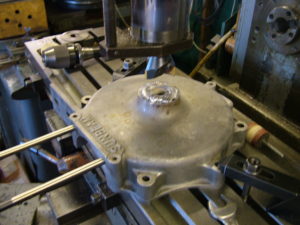
The early type riveted crankshaft needed serious work before Chris deemed it fit for service.
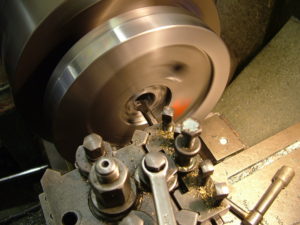
The hair-pin spring cylinder head was in good order and already fitted with a massive 2″ inlet valve. The gearbox too was in fine fettle with its original Sunbeam close ratio gears. We used a low’ish-compression standard Sunbeam piston that had come with the bike thinking we might fit one of my own forged high-compression items at a later date. In due course Chris completed his work on both engine and gearbox and I collected them from the West Coast of Scotland. I didn’t enjoy the drive back home in near blizzard conditions with our precious cargo despite Chris’ assurances that they rarely get snow in those parts. It was worth the trip.
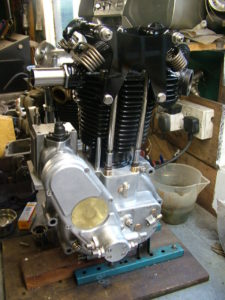
The next step was a dry-build in my “dining room” using wheels borrowed from the 1930 bike and it was during this process that I began to fully appreciate the quality of the work that Peter had already performed in preparing the motorcycle. Peter has built several Sunbeam motorcycles that are on display in the National Motorcycle Museum and his skills are not in any doubt. Where the original parts were beyond salvage, they had been re-recreated with painstaking attention to detail and care. So meticulous in fact the Peter not only makes special tooling to correctly profile the ends of the engine mount studs, he also adjusts the length to ensure only one thread is visible past the correct, double chamfered Sunbeam pattern nuts. I assembled the bike almost entirely by hand like an Airfix kit, such was the quality of the fittings and fasteners that a spanner was rarely required.
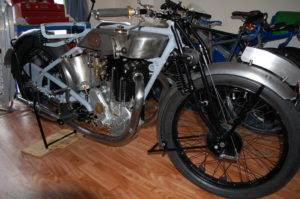
Square ML… M90 stamped Amac 10MDY carburettor… 1928-only profile silencers… Sunbeam fuel tap with filter bowl… Sunbeam oil regulator… CMC oil-petrol caps… armoured racing-spec. oil pipes with unions and elbows… sports twist-grip… Bentley & Draper dampers… English Lever toolbox lock… all the nice bits were present and most importantly, correct
At this point, my original plan to spray it black and just ride it went out of the window. Closely followed by the cheque book.
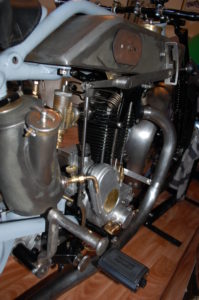
I’ve never owned or built a vintage bike that was to concours standard but anyone could see that here was an opportunity to do just that. It would certainly be a feather in the cap of a so far eclectic yet perhaps lack-lustre motorcycling career. What was needed? Just wheel building, painting, plating and careful assembly. Or so one would think. At this point I engaged the services of my long-suffering friend John Phizacklea. John has built and painted many fine motorcycles winning many accolades along the way and is a Sunbeam man to boot. Neither of us could predict that this simple paint and plate job was going to take the best part of the next three years.
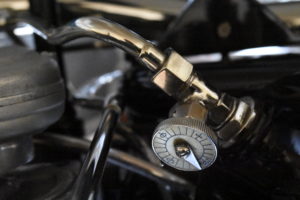
John started work on the bike with one of the first jobs being to source new rims, have them dimpled and rebuild the wheels onto the Sunbeam hubs. We opted for a sporty 21″ front and 19″ rear as I think there is a better feeling with the larger front option. The correct 11 gauge spokes for the front are no longer available anywhere or at any price and so we had to settle for the slightly thicker 10 gauge. Peter Woodward continued to be involved in the project and was subject to many lengthy phone calls as I struggled to work out how the different elements of the bike were to be presented. His powers of recall and detailed knowledge of all things Sunbeam is frankly astonishing and without his support the bike wouldn’t have reached this point or standard of authenticity. It was during one of these discussions that Peter mentioned that original pattern Sunbeam spoke nipples could be replicated by turning the end of the nipple so that it tapers down and blends into the spoke. I don’t know how many hours it took John to turn down the square ends of all 80 nipples but I do know he vowed never to repeat the process.
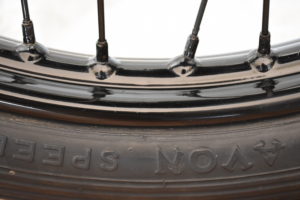
A particularly agonising moment came when discussions with Peter revealed that the barrel and head should have been painted in a matt-cum-satin paint rather than the gloss I had asked Chris to use when he built the engine. A quick scan through the Cordon-Champ books confirmed this. It is the different qualities of the black and metal finishes on the Sunbeam that add to the feeling of substance and refinement. Furthermore, Chris had built the engine with a view to being ridden rather than shown which meant that hairspring valve guides featured an oil feed on the exhaust valve and aluminium retainers. The difficult decision was taken for John to strip and refinish the engine whilst talented young engineer Chris Fisher produced new valve guides and retainers to pretty much the original Sunbeam pattern.
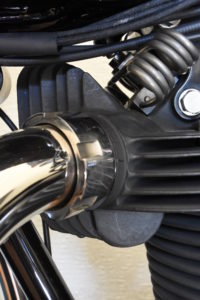
As John was rebuilding the engine I spent a lot of time with Archie and Peter trying to figure out the correct finish for the various fasteners on the bike. It was a feature of the Marston Sunbeam that many of the nuts were black finished with a double chamfer so that washers were not required. The fillister profiled nickel plated ends of the engine mount studs would gleam like jewels buried in the deep black of the nuts and mounting plates. Our stud are stainless steel with polished ends as its virtually impossible to stop the nickel plate from pinging off the ends of plated studs.
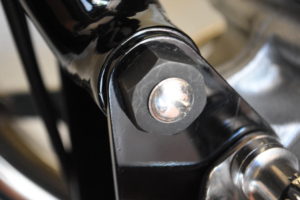
In due course, a lengthy list was compiled of what parts of the bike were to be nickel plated, chemically blacked or painted. On original bikes of course much would have been stove enamelled by Marston’s with items like the mudguard and stays finished as one complete assembly. Doug Taylor Metal Finishing performed all the nickel plating on the bike taking special care not to polish out any of the writing on caps and levers whilst John set about painting the bike with a finish like black glass. I had little input at this point and took a back seat whilst the bike slowly came together in John’s capable hands. Its always easier to work to a target and so we decided that it would be great idea to show the bike at Stafford in the Spring of 2014. Perhaps inevitably, it went down to the wire and the first time I set eyes on the bike was helping John unload it and wheel it into the private entries area of the exhibition hall. The bike looked fantastic and was well received at the show being lucky enough to win a “highly-commended” against stiff competition.
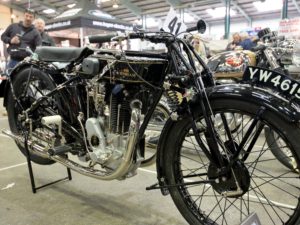
Whilst obviously proud and delighted with this result, deep down I felt there was something missing. Somehow we hadn’t done the bike justice and the cheap Chinese bulb horn on the bike was a faux-pas that had cost us dear. John took the bike back to Chiseldon and whilst he completed that last couple of outstanding jobs it dawned why I wasn’t yet happy. The problem was that in common with many others, we had taken the easy route, the coward’s way out and probably deserved a white feather rather than a rosette. This simply wasn’t how your wealthy, play-boy enthusiast would have ordered his motorcycle from the Marston factory. My man would be using his high-powered sports bike to ride out on a Sunday to play cricket or with an overnight bag slung on the back for a shooting weekend. My man would almost certainly have thrilled a young lady with the startling acceleration as he drove to some secluded spot on a sunny afternoon. For inspiration I turned to Archie Beggs.
The eureka moment came when I considered Archie’s own ’28 bullnose 90 and concluded the way forward was to reconfigure the bike as the quintessential gentleman’s sports-tourer. Surely it would be simple enough to fit a rack, lighting kit and a speedometer? A quality bulb horn too perhaps? Rather than a stripped-down racer, quality period-fitment accessories would add a whole new dimension of interest and detail to the bike. Of course it did not go to plan and the budget was thrown completely out of the window a second time.
After discussing this new direction with Peter Woodward he remembered passing on a 100mph time and trip Bonniksen to a gentleman who it turned out still owned it and was also willing to let it go. At a price. It had to be completely restored and of course The Bonniksen Boy was the only person who could be trusted to the task. It turned out that the Veeder Root trip meter wasn’t functioning and Steve Knight had already warned me that this was usually not repairable as they are more or less a sealed unit. We got lucky this time and some time later a beautifully restored and fully operational speedo and gearbox were posted to John complete with new cable and gears.
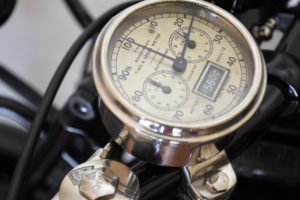
John P spotted a rather nice early Lucas headlamp at Stafford which turned out to be an SS47 with original fluted glass and of the type where the control switch revolves around the ammeter. Pretty much correct for the year and the same as the one fitted to Archie’s own bike, I had little choice but to hand over the cash. It provides a fine view from the saddle mounted proudly in front of the speedo on some period swan-neck headlamp mounts. Paul Milner turned up a 1929 Lucas MDB1 magdyno which, other than Dave Lindsley, none of the usual experts wanted to touch. Unfortunately we couldn’t live with their lead time for the work and I was then introduced to D H Day who did a fine job of the restoration work that included producing new magnets. The MDB1 itself wasn’t a great success at the time being prone to stripping the dynamo drive gears and was quickly superseded but it is the correct fitment and so has replaced the square ML which has gone back to stores. Jiri Horice at Vintage Replica provided a perfect replica MT110 whilst eBay surprised me with a genuine new-old-stock Lucas battery which made a nice finishing touch. It hasn’t had any acid in it yet but I’m sure it will still work. It was decided that showing the bike at Stafford again in Spring 2016 would prove a useful yet easily achievable target for completion of the work. The bike would look very different from its previous appearance.
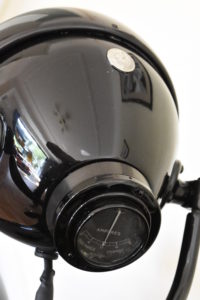
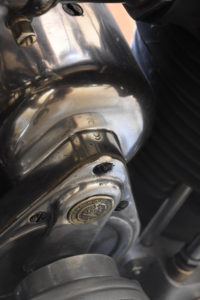
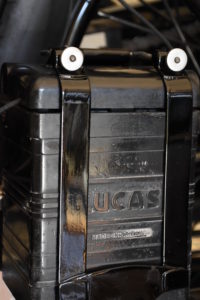
Whilst all this was going on, John set about copying a Sunbeam rack from one borrowed from a friend. Tooling had to be custom made in order to create the correct profile for the rack mounting points but the end result is indistinguishable from the original. A pair of new toolboxes were fabricated and leathered to suit. This proved to be the start of some trials as it was quickly apparent that the rack wouldn’t fit the bike due to the arrangement of the rear mudguard stays which were to the ’27 pattern rather than the later ’28 scissor stays.
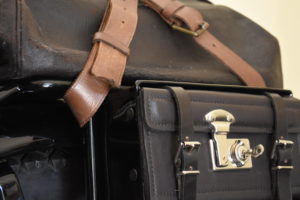
We kicked this problem back and forth over a few weeks and concluded that, rather than mess up the existing guard and stays produced by Peter, we would source a new mudguard from Les Hobbs and manufacture new stays to suit. This would mean that the bike could be easily converted from touring spec. to race-trim by removing the lights, refitting the square ML and replacing Peter’s mudguard and low mounted toolbox. Two bikes in one!
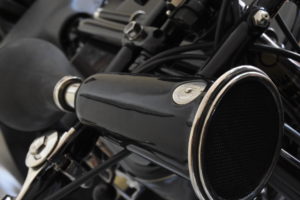
Stafford approached and time was getting tight. Really tight. So tight that John’s wife had already moved house to Cornwall ahead of him whilst he stayed behind in a caravan to finish off. The day before we were due to setup at the show, the bike was in bits, the mudguard still hadn’t been painted, the period cloth covered wiring had just been delivered and the speedo gearbox suffered minor damage whilst being adjusted in the lathe. Serious time had already been lost repainting the petrol tank after we realised the words “The Sunbeam” on the left hand side should not have been written inline but stacked vertically. Big deal? Well yes, it is one of the details that differentiate the ’28 Model 90 from other years and models.
Leaving the workshop at 10pm on the Friday night before the show as John sped down to his new Cornish farm advice to not touch the wet paint for at least 48 hours were ringing in my ears. It left me wondering how I was going to unload the ruddy thing from the van without handling it. Regardless, early the next morning I found myself wheeling the bike into the private entries area and, tired, sat down on the concrete floor to properly look at it for the first time in its new guise. John had pulled out all the stops and in my eyes at least looked wonderful. There were now so many beautiful things to look at on the bike it was like a fractal image. I had hopes of an award for sure but I knew there were still some things not quite right and there were some very well restored bikes on display. Maybe 2nd or 3rd in “Best Vintage” was in reach if the judges were generous and the wind blew in my favour? Sunday morning I confess to being disappointed to find that the bike wasn’t mentioned in “Best Vintage” nor did it appear to merit a “highly-commended” award. As I walked away to explore the show, something made me double-back to scan the full list of awards. The breath was completely knocked out of me when I saw at the top of the list the bike had won “Best at show”. This was unexpected. I phoned John, Peter and Chris immediately to let them know the good news and thanked them for all their efforts and patience as the award is undoubtedly theirs. I left the show that evening a very proud and happy man.
